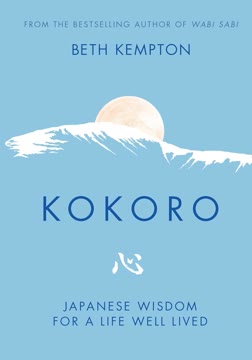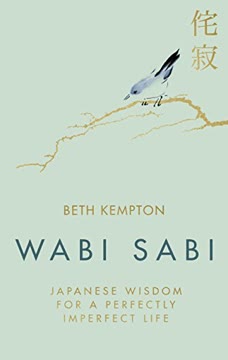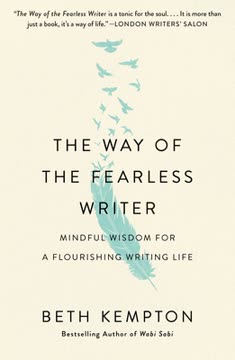Key Takeaways
1. Kokoro: The Intelligent Heart Illuminates Life's Path
The kokoro is the intelligent heart, which communicates our innate wisdom and responds to the world in the present moment, in the form of felt impulses.
Beyond Simple Translation. Kokoro, often translated as "heart," encompasses mind, spirit, and soul. It's the source of innate wisdom, untainted by societal pressures or external opinions. It guides us through felt impulses, helping us navigate relationships and life choices with ease and freedom.
Accessing Innate Wisdom. The kokoro is a mechanism for accessing the soul’s intelligence and our deepest wisdom. It is the source of our innate capacity for feeling the innermost nature of things (which join us to each other and the world we live in), as well as the source of our natural creative response to the world. In Japanese culture, the understanding of this felt language of the kokoro is absolutely essential in navigating relationships, appreciating beauty, and responding to the world from moment to moment.
A Personal and Invisible Force. The kokoro is both generative and responsive. It's the flutter of the heart when witnessing beauty or the tightening when facing sorrow. It's a wealth of spiritual richness, guiding us toward a life well-lived, beyond material possessions.
2. Embracing Impermanence: Death as a Guide to Living Fully
A life well lived is a life lived in full awareness of the impermanence of everything.
Facing Mortality. The book explores the author's journey through grief after the loss of a close friend and her mother, prompting a deep reflection on mortality. This awareness of impermanence becomes a catalyst for re-evaluating life's priorities and making intentional choices.
Death as a Teacher. The author learns that facing death can teach us how to live more fully. It encourages us to treasure what is precious, let go of what doesn't matter, and trust in our own heart's wisdom. It is a reminder to cultivate a strong sense of what really matters, so we can treasure it before it is lost, and make the most of every day.
The Gift of Clarity. The experience of loss brings a new clarity, stripping away the superficial and highlighting the importance of love, connection, and gratitude. It's a call to live each day with intention, knowing that time is precious and not guaranteed.
3. Stillness and Silence: Tuning into the Kokoro's Wisdom
A life well lived is a life enriched by stillness.
The Power of Space. The book emphasizes the importance of creating space and stillness in our lives to tune into the wisdom of the kokoro. This involves disconnecting from the constant noise of the modern world and finding moments of quiet contemplation.
Learning from Nature. Drawing inspiration from figures like Zen poet Ryōkan, the author explores how nature can be a source of stillness and inspiration. Spending time in nature, away from distractions, allows us to listen to our inner voice and gain clarity about what truly matters.
Spaciousness and Potential. Stillness is not just about quietening the mind; it's about creating a fertile void from which newness can arise. It's about leaving white space in our lives for the unknown, allowing for a widening of perspective and the emergence of new possibilities.
4. Timefulness: Being Present in the River of Existence
A life well lived is a life we are present to.
Beyond Linear Time. The book challenges our conventional understanding of time as a linear resource to be managed and controlled. Instead, it introduces the concept of "being-time," where existence and time are intertwined.
The Eternal Now. Drawing on the teachings of Zen Master Dōgen, the author explores the idea that each moment contains all of time—the past, present, and future. This perspective encourages us to be fully present in each moment, giving it our full attention.
Living in the Flow. By embracing the concept of being-time, we can shift from "doing-time" (a life governed by schedules and obligations) to a more fluid and intentional way of living. This involves surrendering to the moment, letting go of striving, and simply experiencing life as it unfolds.
5. Heart-Mindfulness: Navigating Life with Sensitivity and Awareness
A life well lived is a life experienced heart-mindfully.
Beyond Rationality. The book advocates for a way of living that goes beyond rational decision-making and embraces heart-mindfulness. This involves tuning into our feelings and responding to the world with sensitivity and awareness.
The Language of Feeling. Heart-mindfulness is about recognizing the energetic impulses that arise within us in response to the world. It's about trusting the intelligence of our kokoro and allowing it to guide our choices.
Joy as a Compass. By making decisions guided by joy and other positive emotions, we navigate life in a different way. Our days look different, and we feel different at the end of each one. We might call this feeling approach “heart-mindfulness.” We don’t make a conscious decision to feel a certain way, the feeling just arises, and we are aware of its arising.
6. Rebirth and Renewal: Letting Go to Become Who We Are
A life well lived is a life fully expressed.
The Cycle of Change. The book explores the concept of rebirth as a continuous process of letting go and becoming. This involves shedding old identities, beliefs, and patterns that no longer serve us.
Embracing Vulnerability. Rebirth requires courage and vulnerability. It's about being willing to dissolve who we thought we were in order to become who we are destined to be.
The Power of the Present. By embracing the process of rebirth, we can live more fully in the present moment. We can let go of the past and open ourselves to new possibilities, knowing that each day is a chance for a new beginning.
7. Nourishment: Cultivating Goodness Within and Without
A life well lived is a life well nourished.
Beyond Physical Sustenance. The book emphasizes the importance of nourishing ourselves on all levels—physical, emotional, and spiritual. This involves being mindful of what we take in, from the food we eat to the media we consume.
The Kokoro and Digestion. Everything we take in goes so deep into our bodies and affects the functioning of every part of us, down to the decisions we make about the way that we live.
The Power of Omoiyari. The book highlights the Japanese concept of omoiyari, which involves thoughtfulness and care for others. This extends to the way we prepare and share food, creating a sense of connection and community.
8. Intentionality: Choosing a Life of Gratitude and Purpose
A life well lived is an intentional life, lived fully and in gratitude.
Beyond Material Wealth. The book challenges our conventional notions of success and encourages us to prioritize a "wealth of kokoro" over material possessions. This involves focusing on the richness of our inner life and the impact we have on others.
Living with Purpose. Intentionality is about making conscious choices that align with our values and passions. It's about living a life of purpose, guided by our kokoro and a deep sense of gratitude.
The Power of Now. By living intentionally, we can make the most of each day, knowing that time is precious and not guaranteed. We can create a legacy of love, kindness, and compassion that extends far beyond our own existence.
Last updated:
FAQ
1. What is "Kokoro: Japanese Wisdom for a Life Well Lived" by Beth Kempton about?
- Exploration of Kokoro: The book delves into the Japanese concept of kokoro, which encompasses heart, mind, and spirit, and how it shapes a meaningful, well-lived life.
- Personal Pilgrimage: Beth Kempton shares her own journey through midlife, grief, and self-discovery, using Japanese wisdom and cultural practices as a guide.
- Structure Around Sacred Mountains: The narrative is organized around pilgrimages to the three sacred mountains of Dewa Sanzan—Hagurosan (present), Gassan (death/past), and Yudonosan (rebirth/future)—each representing a stage in the cycle of life.
- Blend of Memoir and Philosophy: The book combines personal stories, interviews, and philosophical reflections, offering both practical advice and deep cultural insights.
2. Why should I read "Kokoro: Japanese Wisdom for a Life Well Lived" by Beth Kempton?
- Unique Cultural Perspective: The book offers a rare, in-depth look at Japanese wisdom, especially the nuanced concept of kokoro, which is not easily translated into English.
- Guidance for Life Transitions: It provides gentle, thoughtful advice for navigating midlife, grief, and times of change, making it relevant for anyone facing personal transitions.
- Practical and Reflective: Each chapter ends with "Kokoro Work" journaling prompts, encouraging readers to reflect and apply the lessons to their own lives.
- Beautiful Writing and Inspiration: Kempton’s poetic storytelling and real-life encounters with Japanese teachers, monks, and artists make the book both moving and motivational.
3. What is the meaning of "kokoro" as explained in Beth Kempton's book?
- Multifaceted Concept: Kokoro is described as the intelligent heart, encompassing heart, mind, and spirit, and is the source of innate wisdom and felt impulses.
- Heart-Mind-Spirit Unity: Unlike English, which separates heart, mind, and spirit, kokoro unites them, guiding how we feel, think, and respond to the world.
- Source of Authentic Living: Kokoro is seen as the internal compass that helps us navigate relationships, creativity, and life choices with sensitivity and presence.
- Essential to Japanese Culture: The book emphasizes that kokoro is central to Japanese language, art, and daily life, appearing in hundreds of words and cultural practices.
4. What are the twelve principles for a life well lived in "Kokoro: Japanese Wisdom for a Life Well Lived"?
- Self-Examination: Regularly reflect on your life and feelings to ensure alignment with your true self.
- Heart-Mindfulness: Experience life by tuning into your kokoro, rather than overanalyzing with the rational mind.
- Embrace Stillness: Seek moments of quiet and spaciousness to hear your inner wisdom.
- Presence and Impermanence: Live fully in the present, aware of the fleeting nature of all things.
- Love and Bittersweetness: Recognize that love and loss are intertwined, and both enrich life.
- Climbing Life’s Mountains: View challenges and transitions as essential parts of growth and fulfillment.
- Integrated Layers: Accept and honor all stages and versions of yourself throughout life.
- Wholehearted Expression: Express your creativity and inner truth without fear or self-censorship.
- Nourishment: Prioritize what nourishes your body, relationships, and kokoro.
- Intuitive Path: Let your kokoro guide you toward what feels right, rather than external expectations.
- Intentional Living: Live with gratitude and intention, making conscious choices each day.
5. How does Beth Kempton use the three sacred mountains of Dewa Sanzan to structure her book and its lessons?
- Hagurosan (Present): Represents taking stock of your current life, focusing on presence and earthly desires.
- Gassan (Death/Past): Symbolizes facing mortality, grief, and the lessons that death and endings teach about living well.
- Yudonosan (Rebirth/Future): Stands for rebirth, renewal, and intentionally shaping the future with the wisdom gained from past experiences.
- Pilgrimage as Metaphor: The journey up each mountain mirrors the internal journey through self-examination, letting go, and embracing new beginnings.
6. What practical advice and methods does "Kokoro: Japanese Wisdom for a Life Well Lived" offer for everyday life?
- Kokoro Work Journaling: Each chapter ends with reflective questions to help readers apply the book’s wisdom to their own lives.
- Heart-Mindfulness Practice: Encourages tuning into felt impulses and emotions, rather than relying solely on logic or external validation.
- Stillness and Spaciousness: Suggests creating moments of quiet and “white space” in daily life to allow for insight and creativity.
- Cleansing the Kokoro: Recommends rituals such as spending time in nature, meditating, or simply pausing to reset your emotional state.
7. How does "Kokoro: Japanese Wisdom for a Life Well Lived" address grief, loss, and mortality?
- Personal Stories of Loss: Kempton shares her experiences with the deaths of her mother and a close friend, offering an honest look at grief.
- Japanese Perspectives on Death: The book explores how Japanese culture integrates death and impermanence into daily life, art, and ritual.
- Grief as Kokoro Work: Grief is framed as essential work of the kokoro, transforming pain into wisdom and deeper appreciation for life.
- Embracing Impermanence: Readers are encouraged to accept the transient nature of all things, which leads to greater presence and gratitude.
8. What is "heart-mindfulness" and how does it differ from Western mindfulness, according to Beth Kempton?
- Feeling Over Thinking: Heart-mindfulness is about tuning into the kokoro—your felt sense and emotional responses—rather than analyzing with the rational mind.
- Present-Moment Sensitivity: It emphasizes being alive to each unfolding moment, responding authentically rather than following pre-set plans or expectations.
- Joy in Simple Acts: The practice values doing things for the joy they bring, not just for achievement or future utility.
- Cultural Context: Heart-mindfulness is rooted in Japanese traditions and language, offering a more integrated approach than some Western mindfulness practices.
9. How does "Kokoro: Japanese Wisdom for a Life Well Lived" suggest we approach time and presence?
- Being-Time Concept: Drawing from Zen Master Dōgen, the book teaches that we are not separate from time; we are time itself, and each moment is precious.
- Letting Go of Linear Time: Kempton encourages readers to move beyond rigid schedules and efficiency, focusing instead on the fullness of the present.
- Rituals of Attention: Practices like moon-viewing, meditation, and mindful eating are offered as ways to honor the present moment.
- Making Space for What Matters: The book advocates for clearing physical and mental space to allow for presence, creativity, and meaningful connection.
10. What role does creativity and self-expression play in "Kokoro: Japanese Wisdom for a Life Well Lived"?
- Kokoro as Creative Source: The book posits that creativity is an instrument of the kokoro, allowing us to express our deepest wisdom and connect with others.
- Midlife and Creative Urges: Kempton notes that midlife often brings a strong desire for creative expression, which should be honored and explored.
- Fearless Expression: Readers are encouraged to let go of perfectionism and fear, expressing themselves wholeheartedly in whatever form feels right.
- Everyday Creativity: Creativity is not limited to art; it includes how we live, parent, work, and interact with the world.
11. How does "Kokoro: Japanese Wisdom for a Life Well Lived" define success and a life well lived?
- Inner Fulfillment Over Outer Achievement: Success is redefined as the richness of your inner life and the quality of your relationships, not external accomplishments.
- Joy, Beauty, and Wonder: A life well lived is one where you find and share joy, beauty, and wonder, regardless of material status.
- Living in Alignment: The book emphasizes living in accordance with your kokoro, making choices that feel right rather than those that simply look good to others.
- Legacy of Impact: True legacy is measured by the positive impact you have on others and the traces of your kokoro left behind.
12. What are the best quotes from "Kokoro: Japanese Wisdom for a Life Well Lived" by Beth Kempton, and what do they mean?
- “A life well lived begins and ends with the kokoro.” — This encapsulates the book’s central message: your heart-mind is both the starting point and the culmination of a meaningful life.
- “We get to have this day.” — A reminder to cherish each day as a unique opportunity, especially in the face of loss and impermanence.
- “The kokoro is the heart that thinks and the mind that feels.” — Highlights the integrated, holistic nature of kokoro, uniting emotion and intellect.
- “The point of prayer in any form is not to ask for what we want, but to offer thanks for what we already have.” — Encourages gratitude and presence over striving and desire.
- “Let the kokoro be our guide.” — Suggests that by tuning into our inner wisdom, we can navigate life’s challenges and transitions with authenticity and grace.
Review Summary
Kokoro receives mostly positive reviews, praised for its blend of Japanese wisdom, personal memoir, and self-help guidance. Readers appreciate Kempton's exploration of grief, midlife challenges, and cultural insights. Many find the book thought-provoking and transformative, with useful reflection exercises. Some critics note familiar self-help concepts repackaged with Japanese themes. The book's structure, writing style, and cultural depth are generally well-received. Readers value its insights on slowing down, embracing nature, and living mindfully, though a few find it lacks practicality for those with limited resources.
Download PDF
Download EPUB
.epub digital book format is ideal for reading ebooks on phones, tablets, and e-readers.








